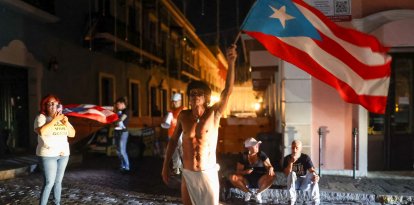Storm hits the east of the country with rain, flood risk and tornadoes
Inclement weather, which will last throughout the week, may affect early travel plans for Americans during the holidays.

(X @tropicalupdate)
The eastern part of the country will face a stormy Sunday, with the possibility of flooding and tornadoes. About 62 million Americans will be under a flood warning through Monday, according to The Weather Channel.
"The major system will start to produce showers and thunderstorms over parts of the southern Mid-Atlantic Coast northward to New England," warned the National Weather Service, which extended the excessive precipitation warning until Monday. "The associated heavy rain will create mainly localized areas of flash flooding, with urban areas, roads, and small streams the most vulnerable."
The state agency also warned of severe storms in eastern North Carolina and the eastern coast of South Carolina. "The hazards associated with these thunderstorms are frequent lightning, severe thunderstorm wind gusts, few tornadoes, and a minimal threat of hail."
The entry of the storm into Florida has left almost 30,000 Floridians without power, according to data from PowerOutage.us. "We are safely and quickly responding to outages caused by severe weather impacting parts of Florida, including heavy rain and wind gusts near tropical-storm-force strength," said the energy provider Florida Power & Light. The company also asked its customers to stay away from downed power lines.
This storm system could be joined by another from Texas, which will arrive with rain and snow, according to Fox Weather.
How will the storms continue?
The storm that hit part of the United States on Sunday will move into Canada on Monday afternoon, including the strong winds, showers and thunderstorms that were experienced on U.S. soil.
In turn, this storm system will be affected by colder air, which will increase the likelihood of snowfall in eastern Canada, particularly in the Appalachians, the Great Lakes region and Ontario.
A white Christmas?
The forecast may cause delays for those traveling early this holiday season. One of the sources of possible traffic jams will be Interstate 95 (I-95), where the storm is expected to head north. As Fox Weather meteorologist Britta Merwin warned:
This comes with an expected increase in the number of cars on the road and flights, which could also be modified due to bad weather: 115.2 million people will travel at least 50 miles from their homes, according to the AAA Auto Club. This represents an increase of 2.2% compared to last year and is the second-highest figure the AAA has ever recorded.
Although the weather expected for the holidays remains uncertain, some local National Weather Service services warned of rain. This is the case for inhabitants of Shreveport, LA:
Likewise, a white Christmas seems unlikely for most Americans. According to AccuWeather expert Paul Pastelok, the most common outcome will be a "green Christmas."According to the site, those in the Rockies or inland areas of the Northeast will be more likely to see snow.
Winter and the El Niño phenomenon
As in 2015, the North American winter will be affected by the El Niño phenomenon, which raised the temperature in December and caused the highest temperature ever recorded in cities such as Albany, New York City, Burlington and Vermont. Therefore, it is expected that it could have a similar impact in the latter part of 2023 and the first part of 2024.
What is this phenomenon about? According to the World Meteorological Organization, it occurs every two to seven years when the surface water temperature of the Central Pacific Ocean along the equator warms a few degrees above its historical averages.
Particularly in the United States, it is expected to cause wetter and cooler weather in the south, while somewhat drier and warmer in the north.
RECOMMENDATION





















